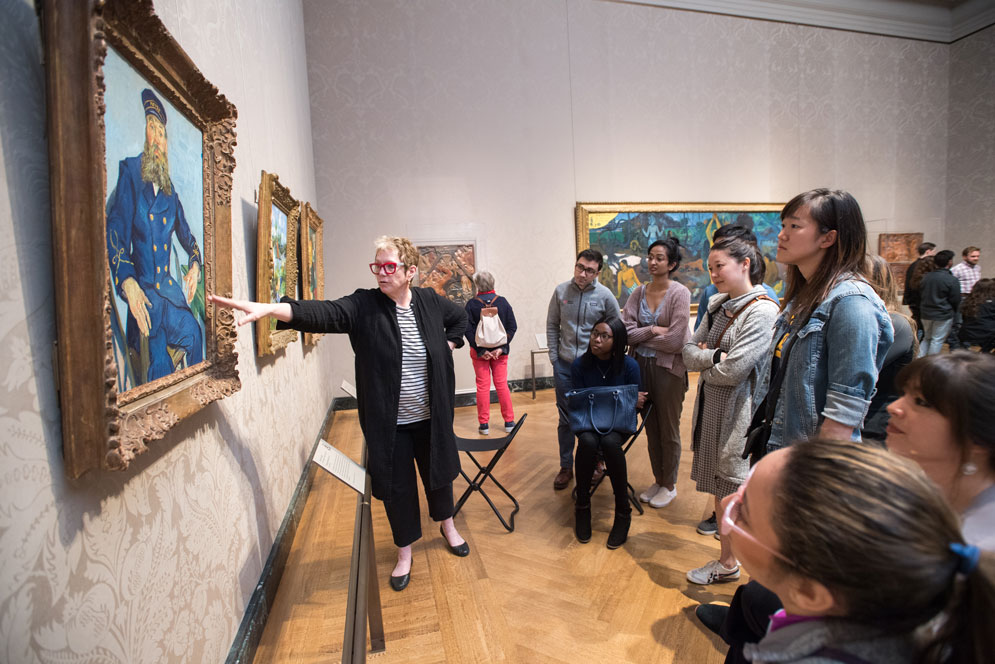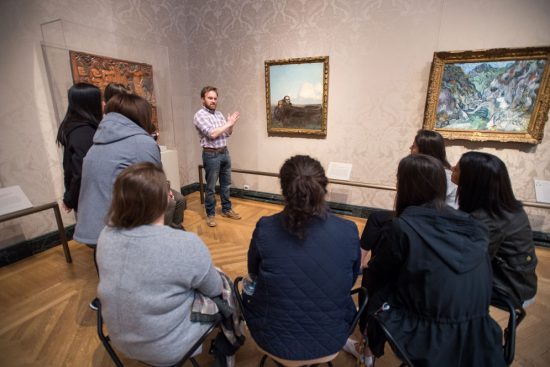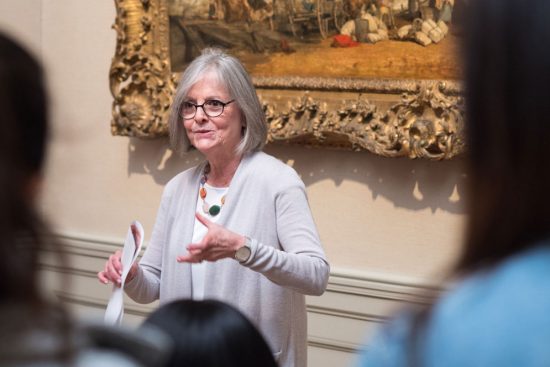Making the Rounds Among the Old Masters
BUSM students visit Boston’s MFA to deepen their powers of observation
 Lynne Allen, a CFA School of Visual Arts professor, discusses Vincent Van Gogh’s 1888 portrait of Postman Joseph Roulin with a group of MED students at the Museum of Fine Arts.
Lynne Allen, a CFA School of Visual Arts professor, discusses Vincent Van Gogh’s 1888 portrait of Postman Joseph Roulin with a group of MED students at the Museum of Fine Arts.
On a recent spring morning at the Museum of Fine Arts, two dozen School of Medicine students stare up at Joseph Mallord William Turner’s circa-1805 oil painting Fall of the Rhine at Schaffhausen. The mammoth canvas, nearly 5 feet high and 8 feet wide, depicts a surging Alpine waterfall that dwarfs the human figures at the bottom of the frame.
“There are no wrong answers, no grades, this is purely an opportunity to practice observation,” says Lynne Allen, a College of Fine Arts School of Visual Arts professor, and one of three faculty facilitators accompanying the students on this visit. “Everything we do in medicine and in art begins with observation.”
The third-year students, in the middle of their psychiatric rotation, are asked to look deeply and react to whatever strikes them as significant, from the story an artwork tells, to its composition, to the artist’s use of colors and brushstrokes. Whether on rounds in a ward or one-on-one with a patient in a treatment room, doctors need to be able to see both the obvious and the subtle. The MED program nudges the students out of their white-coat cloister, sharpening their observational skills by applying them to art.
“In the upper left corner there’s a rainbow and I thought that was really interesting,” says MED student Mikayla Huestis (CAS’16). “All the water is devastating these poor little people. But then you have this beautiful rainbow—it’s majestic and more uplifting. Even in tragedy there’s a silver lining.”
“I didn’t see the rainbow at all until you brought it up,” says Allen. “That’s what’s interesting about this process. You’re going to see something I didn’t see, and I’m going to see something you didn’t see.”
Inspired by reading about a similar program at Yale, Andrew Clark, a MED assistant professor of psychiatry, put the program together in the spring of 2018 with Richard Raiselis, a CFA School of Visual Arts associate professor. Eight groups have visited the MFA over the last year: typically, they’ll look at five works of art. Each group focuses on different works in the MFA’s collection.
The students are asked to say what they see going on in each work and discuss why they have that particular impression or perception. While they may see very different things initially, by the end of the discussion they often reach more of a consensus, and learning how to do that is one of the most important parts of the exercise.
“What they’re doing in front of a painting is similar in important ways to what they’d be doing on a ward,” Clark says, “where they’re being asked to observe a patient carefully, to gather observations and data, to communicate that to the treatment team, and then work together with other members of the team to develop a coherent understanding of the individual in front of them.”
The facilitators are there to help focus the conversation but also to provide technical and historical context for the art. The department of psychiatry has supported the program, Clark says, but it’s not really specific to psychiatry. A number of medical schools are doing something similar, including a program underway at BU’s Henry M. Goldman School of Dental Medicine.
After discussing the Turner painting, students and faculty break into smaller groups to rotate among three other paintings. Vincent Van Gogh’s 1888 portrait of Postman Joseph Roulin draws contradictory assessments of his mood based on posture and facial expression, either “confident” or “not confident at all” or “not confident trying to act confident.” Someone comments that the postman’s hands seem deformed, and Allen notes that it could be the postman has arthritis or it could simply be Van Gogh’s approach.
“There’s a lot of things here that are not anatomically correct,” cautions Allen. “Van Gogh saw things the way he saw things, and accuracy is not always the first thing he was going for.”
Moving on, she says, “I want to ask you as medical doctors to look at his face, look at this cheek, this ruddiness.”
“Seborrheic dermatitis,” a student says to laughter.
“Or he drinks a lot,” says Allen.
 Marc Schepens, a CFA School of Visual Arts lecturer, helps a group of MED students understand why Odilon Redon’s 1899 oil The Angel of Destiny makes them uncomfortable.
Marc Schepens, a CFA School of Visual Arts lecturer, helps a group of MED students understand why Odilon Redon’s 1899 oil The Angel of Destiny makes them uncomfortable.
Odilon Redon’s 1899 oil The Angel of Destiny is an outlier artistically, a spooky image of an ambiguous figure with a skiff on an empty shore, which makes some students uncomfortable: He or she? Human or wraith? “The funny thing about ambiguity is, how you interpret it becomes a reflection of yourselves,” says Marc Schepens (CFA’12), an SVA lecturer at CFA and the third faculty facilitator.
Edgar Degas’s Ballet Dancer with Arms Crossed, an oil painting circa 1872, leaves the students debating whether the dancer is winding down from a rehearsal or waiting to go on during a performance.
“She’s not impressed with whatever she’s looking at,” says MED student Sean Perez.
“Why do you say that?” asks facilitator Susan Warren, a psychiatrist who is an instructor in the department of psychiatry at UMass Medical School and a consultant to the School of Visual Arts.
 Susan Warren, a Brookline psychiatrist, talks about the scale and drama of Joseph Mallord William Turner’s painting Fall of the Rhine at Schaffhausen.
Susan Warren, a Brookline psychiatrist, talks about the scale and drama of Joseph Mallord William Turner’s painting Fall of the Rhine at Schaffhausen.
“She has, like, a skeptical look,” Perez says. “From what you can see of her eyes.”
“It looks to me like she’s crying, the way her shoulders are angled downward and in,” someone else says.
“She’s more pensive and focused on the internal, whatever she’s dealing with,” says student Karen Cuttin.
“The proportion of her wrists is off, like she has a Colles Fracture,” adds Perez, getting another laugh.
The final work the students examine is Tara Donovan’s 2003 sculpture Untitled, a cloud of thousands of Styrofoam cups glued together that hangs from the ceiling in a multistory lobby. It looks like a beehive, someone says. It feels organic, someone else says. Is it a comment on obesity? asks a third.
The MED students consistently give the MFA field trips high marks. “It’s such a different experience than just walking through a museum,” Clark says. “If they can really be present with that piece of art for 10 or 15 minutes, there’s so much they can discern. It’s amazing to me what comes out.”
Several of the students said a morning at the MFA among beautiful art was first and foremost a welcome break from their routine. But others said the exercise would help them going forward.
“In psychiatry everyone has tragic stories and I get very caught up and sad. I’m working on removing myself so I can relate to them without getting caught up,” says Huestis. “Learning to see different perspectives helps you step outside your initial impression and see something in a different way.”
This BU Today story was written by Joel Brown. Photos by Cydney Scott.
View all posts